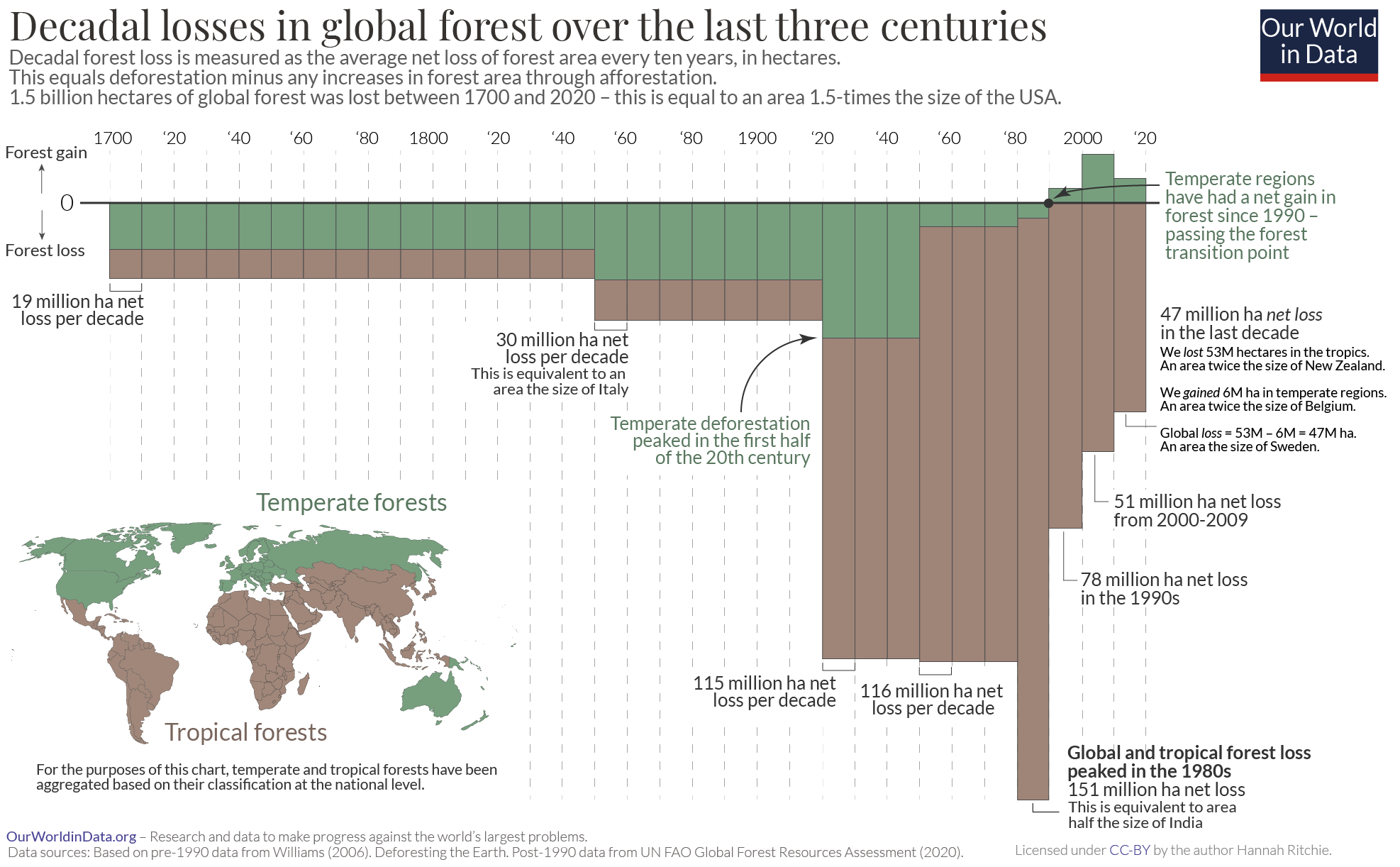Why the world needs a trillion more trees!

Six. Three. One.

We used to have about 6 trillion trees on earth. Tragically, humans have cut down half, so only 3 trillion trees remain. In a perfect world, we would bring back all these lost trees. But we also need land to grow food. So we cannot restore all 3 trillion lost trees.
But there is good news: we can restore up to 1 trillion trees without encroaching on agricultural land.¹
Once these trillion trees are fully grown, these new forests could capture between 488 and 1012 billion tons of CO2. That’s about ¼ to ⅓ of all human CO2 emissions so far (2.2 trillion tons).
But that’s not all! Restoring forests achieves much more than just tackling the climate crisis. By ensuring that these forests recover this helps us avoid the loss of plant and animal species who call these forests home, especially when tropical forests alone house over half of all species on the planet. Regenerating forests can also improve local water quality and reduce erosion.

Wooden Skyscrapers
None of this means that we should never harvest and use trees. 13% of global greenhouse gas emissions are caused by the production of concrete and steel for the construction industry. By building with wood instead, we can avoid these emissions. On top of that, large parts of the carbon absorbed by a tree remain in it.
Of course, we should not harvest trees from old-growth forests. But when we regrow forests, sustainable harvesting some of the trees is an important part of solving the climate crisis. 2
Many Methods to Regrow Forests
Bringing back these trillion trees may be a lot easier than you might think. In many cases forests can recover relatively quickly on their own, so we don’t have to plant all of these trees ourselves. In those areas, all we have to do is to stop standing in the way and nature will plant millions of trees for us. This is usually the case when the area was just deforested when the soil still contains a lot of seeds and there is a lot of intact forest nearby. However, sometimes landscapes are so thoroughly degraded that the only way to bring forests back is to plant trees. Because of this, it is important to carefully consider which restoration approaches will be the most effective in each area so we can restore forests (and a trillion trees!) as fast as possible.
In all the excitement about the power of one trillion new trees, let’s not forget how important it is to protect the three trillion that currently exist. A protected tree is better than a newly planted tree. It takes decades for a new tree to capture the amount of CO2 stored by an old tree. We still lose about 10 billion trees every year. That’s a bit more than all the trees in Germany (~8 billion).


Just Trees is not Enough
On their own, trees cannot solve the climate crisis. We must also drastically cut global carbon emissions by ending the use of fossil fuels, reducing meat consumption and more. Restoring forests can never be a substitute for reducing emissions. At the same time, the crisis is so advanced that just cutting emissions is not enough. We must cut emissions AND restore forests at the same time to prevent global temperature rise above the critical 1.5°C or even 2°C limits.
Moreover, it is not just forest ecosystems that we want to restore. To tackle the climate and the biodiversity crisis, we need to be restoring all ecosystems. Among the most important for climate mitigation are grasslands and peatlands – both of which can store large amounts of carbon when protected and restored.
Literature
Bastin, J.F., Finegold, Y., Garcia, C., Mollicone, D., Rezende, M., Routh, D., Zohner, C.M. and Crowther, T.W., 2019. The global tree restoration potential. Science, 365(6448), pp.76-79.
Brancalion, P.H. and Holl, K.D., 2020. Guidance for successful tree planting initiatives. Journal of Applied Ecology, 57(12), pp.2349-2361.
Chazdon, R.L. and Guariguata, M.R., 2016. Natural regeneration as a tool for large‐scale forest restoration in the tropics: prospects and challenges. Biotropica, 48(6), pp.716-730.
Crowther, T.W., Glick, H.B., Covey, K.R., Bettigole, C., Maynard, D.S., Thomas, S.M., Smith, J.R., Hintler, G., Duguid, M.C., Amatulli, G. and Tuanmu, M.N., 2015. Mapping tree density at a global scale. Nature, 525(7568), pp.201-205.
Di Sacco, A., Hardwick, K.A., Blakesley, D., Brancalion, P.H., Breman, E., Cecilio Rebola, L., Chomba, S., Dixon, K., Elliott, S., Ruyonga, G. and Shaw, K., 2021. Ten golden rules for reforestation to optimize carbon sequestration, biodiversity recovery and livelihood benefits. Global Change Biology, 27(7), pp.1328-1348.
Erb, K.H., Kastner, T., Plutzar, C., Bais, A.L.S., Carvalhais, N., Fetzel, T., Gingrich, S., Haberl, H., Lauk, C., Niedertscheider, M. and Pongratz, J., 2018. Unexpectedly large impact of forest management and grazing on global vegetation biomass. Nature, 553(7686), pp.73-76.
Grainger, A, In Proceedings of the IPCC Conference on Tropical Forestry Response Options to Global Climate Change, São Paulo, (U.S. Environmental Protection Agency, 1990), pp. 93–104.
Griscom, B.W., Adams, J., Ellis, P.W., Houghton, R.A., Lomax, G., Miteva, D.A., Schlesinger, W.H., Shoch, D., Siikamäki, J.V., Smith, P. and Woodbury, P., 2017. Natural climate solutions. Proceedings of the National Academy of Sciences, 114(44), pp.11645-11650.
Hansen, M.C., Potapov, P.V., Moore, R., Hancher, M., Turubanova, S.A., Tyukavina, A., Thau, D., Stehman, S.V., Goetz, S.J., Loveland, T.R. and Kommareddy, A., 2013. High-resolution global maps of 21st-century forest cover change. science, 342(6160), pp.850-853.
Hayek, M.N., Harwatt, H., Ripple, W.J. and Mueller, N.D., 2021. The carbon opportunity cost of animal-sourced food production on land. Nature Sustainability, 4(1), pp.21-24.
Houghton, R. A., In Proceedings of the IPCC Conference on Tropical Forestry Response Options to Global Climate Change, São Paulo (U.S. Environmental Protection Agency, 1990), pp. 88–92.
Humpenöder, F., Karstens, K., Lotze-Campen, H., Leifeld, J., Menichetti, L., Barthelmes, A. and Popp, A., 2020. Peatland protection and restoration are key for climate change mitigation. Environmental Research Letters, 15(10), p.104093.
Intergovernmental Panel on Climate Change (IPCC), An IPCC Special Report on the Impacts of Global Warming of 1.5 °C Above Pre-Industrial Levels and Related Global Greenhouse Gas Emission Pathways (IPCC, 2018).
Shoo, L.P. and Catterall, C.P., 2013. Stimulating natural regeneration of tropical forest on degraded land: approaches, outcomes, and information gaps. Restoration Ecology, 21(6), pp.670-677.
Strassburg, B.B., Iribarrem, A., Beyer, H.L., Cordeiro, C.L., Crouzeilles, R., Jakovac, C.C., Braga Junqueira, A., Lacerda, E., Latawiec, A.E., Balmford, A. and Brooks, T.M., 2020. Global priority areas for ecosystem restoration. Nature, 586(7831), pp.724-729.
Walker, W.S., Gorelik, S.R., Cook-Patton, S.C., Baccini, A., Farina, M.K., Solvik, K.K., Ellis, P.W., Sanderman, J., Houghton, R.A., Leavitt, S.M. and Schwalm, C.R., 2022. The global potential for increased storage of carbon on land. Proceedings of the National Academy of Sciences, 119(23), p.e2111312119.
Yang, Y., Tilman, D., Furey, G. and Lehman, C., 2019. Soil carbon sequestration accelerated by restoration of grassland biodiversity. Nature communications, 10(1), pp.1-7.



